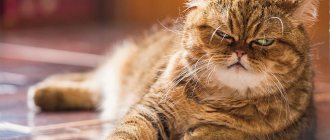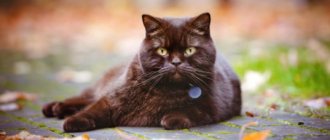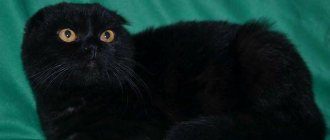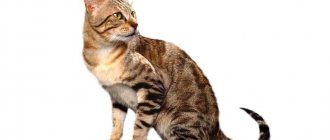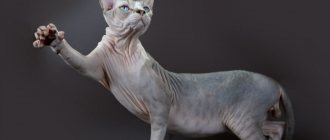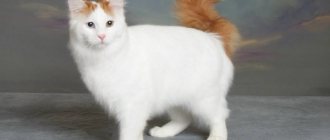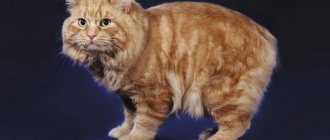The best domestic cat breeds similar to the lynx: features
Among the characteristic features of lynx-like pets, cat lovers especially appreciate the following:
- muscular, squat body;
- short tail;
- hairs of unequal length;
- ears with tassels;
- special eye shape.
The most popular types or breeds of cats that resemble a lynx in appearance:
- Caracal;
- Men-kun with tassels on his ears;
- Pixie Bob;
- Norwegian Forest Cat;
- Kurilian Bobtail.
Caracal
The wild cat is not a close relative of the lynx. Zoologists consider this cat species to be related to the puma. However, lynx fans saw in this pet signs reminiscent of their favorite animal. Kara - feces translated from the Kazakh language means black brush or black ear.
Lives in savannas and semi-deserts of Africa and Asia. It feeds on hares and other rodents, which it hunts at night. It sleeps in rock crevices or burrows, from which it expels foxes. The live weight of adult individuals is 16-30 kg, with a body length without tail of 80-100 cm, and a height of up to half a meter.
Colors range from sandy-yellowish to reddish-cherry, the belly is white. Kittens are spotted from birth, but by six months they become monochromatic.
Rarely found black individuals with blue eyes are especially prized. Caracals are kept in a pen. Living in an apartment with children is unsafe. Caracals are fed raw poultry meat or veal; wild cats refuse dry food.
Maine Coon with ear tassels
Many people argue about the genetic affinity of Maine Coons with lynxes, but avid cat lovers are satisfied with their appearance, which resembles a graceful wild predator. The breed arose as a result of phenotypic selection. The largest individuals reach 13 kg.
Be sure to read:
The most ancient predator is the wild cat Manul, the second name of Pallas's cat: character, behavior
These are graceful and affectionate pets of different colors. A distinctive feature is the tassels on the ears, reminiscent of lynxes. However, based on the length of their tail, they look like a domestic cat.
Maine Coons get along well with household members, as well as with pets of other species. They are adapted to living in an apartment, but feel better in a cottage. A large cat needs to go outside.
The colors are different. However, due to their long coat, they require weekly brushing. Pets prefer to communicate through purring rather than meowing. Maine Coons are fed natural food or ready-made food from premium class and higher.
Pixie Bob
Breeders worked hard on the breed to make the cat as similar to a lynx as possible. The name means "short-tailed elf" in Americanized English. Pixies are comparable in size to ordinary large cats; males weigh no more than 10 kg. A distinctive feature of the paws is six-toed feet. Sometimes there are five-fingered and seven-fingered individuals.
In appearance, Pixies resemble a small lynx: the same tassels on the ears, as well as a short tail. They behave well in the apartment, get along with household members and animals of other species. They are distinguished by good health. Grooming is simple, the main thing is to comb the fur on time, preventing the formation of tangles.
Pixies do not meow, but coo. Like dogs, they signal the arrival of guests. They don't mind being walked on a leash. They are not picky and are content with natural food, as well as ready-made premium food or higher.
Norwegian Forest Cat
They are related to lynxes by the tufts on their ears. The tail length is the same as that of ordinary cats. The breed has been known for several centuries, so its origin is unknown. Cats are distinguished by their strong immunity, waterproof fur, and the ability to climb down from trees upside down. The colors are multi-colored, a fairly large percentage are tortoiseshell.
Cats are moderately playful, calm, and unpretentious. They consume natural products and premium ready-made food equally well. To prevent the formation of mats, your pet should be combed once every 7-14 days.
Cats reach a weight of 9 kg. In appearance, Norwegian cats resemble Siberian cats, and in the habits of lynxes: they tolerate frost and bad weather well.
Be sure to read:
Cheetah-like cat breed: Serval (bush cat, or African cat)
Kurilian Bobtail
Bobtail means short-tailed. The resemblance to lynxes is due to the presence of tufts on the ears. There are short-tailed and tailless individuals. The breed is dominated by short-haired animals of brindle color, but there are individuals with long hair, black, ash, and blue.
Cats are sociable, affectionate, and smart. They know how to get along with other pets and people. They are distinguished by good health and are not picky about food. Males reach a live weight of 8 kg.
Lifestyle, behavior, nutrition
Since lynxes are territorial hunters, they lead a solitary lifestyle. They have a very large range, the largest of any cat. The territories of males are larger and often overlap with the territories of several females.
Lynx nutrition. How does the animal hunt?
Lynx hunts both small and large mammals. Its diet also includes birds and fish.
Although the lynx is a terrestrial mammal, it often climbs trees or swims to catch prey.
The main source of food for the Canada lynx is the mountain hare, even its population increases or decreases depending on the amount of this prey. In addition, its diet includes small rodents such as squirrels, mice, gophers, etc. This species often feasts on birds (such as willow partridges and grouse) if they manage to catch them.
The Eurasian lynx, as the largest species, often hunts ungulates such as deer, roe deer and chamois, supplementing its diet with hares, rodents, birds and their eggs.
A lynx can jump 2 meters in height.
Smaller species - Iberian and red lynxes, usually catch animals no larger than a rabbit.
During the day, the lynx rests in dense thickets of bushes, rock crevices or caves, and with the onset of dusk its active life begins. She has excellent eyesight and exceptional hearing, so she easily finds prey.
Lynxes are not as fast or strong runners as some of their feline relatives. They cannot chase prey, especially if the snow is deep. Therefore, their favorite way of hunting is to ambush their prey. The animal can hide behind trees, stones, bushes or tall grass and wait until a potential victim passes by. In addition, these agile steeplejacks often wait for prey, sitting on tree branches.
The lynx cannot kill a large animal with a blow of its paw, so it deals with it with the help of sharp claws and teeth, thrusting them deep into the body of the victim.
With a lack of food, lynx sometimes have to travel more than 10 km per night. It is especially difficult for her in winter. But despite all the difficulties, this animal is very picky about food: the lynx does not eat carrion, but, as a rule, feeds only on those animals that it has killed itself.
Communication
Like other felids, bobcats use scent glands and urine to mark territorial boundaries and communicate with other individuals.
They can make a variety of sounds similar to those of a domestic cat: meowing, howling, snorting and hissing. And just like domestic cats, they can purr. Mother bobcats often purr when feeding or cleaning her kittens. The growl and howl of the animal can most often be heard during the breeding season.
Reproduction, appearance of offspring
The mating season for lynxes usually occurs at the end of winter - beginning of spring. At this time, several males often follow the female at once. When meeting each other, the animals perform a ritual greeting - they sniff each other’s noses, stand in front of each other and begin to butt heads. Usually silent, during the rut, animals begin to meow a lot, purr and squeal. Fights between males are also not uncommon.
After a pregnancy of about 70 days, the female gives birth to an average of 2 to 5 kittens. There is one litter per year. Kittens are born in dens that are located under fallen branches or tree roots or in rock crevices. If the mother has a lot of food, then the kittens grow quickly; if food is scarce, few survive. The mother feeds them milk for 3-5 months, but already at the age of about two months the kittens begin to try solid food. Gradually, the mother begins to introduce them to the world around them and teach them all the intricacies of hunting.
Young lynxes can fend for themselves at the age of 10 months, but they usually live next to their mother for up to a year - without their mother they would not survive the first winter of their lives. Sometimes siblings who have just left their mother will travel and hunt together for several months before going their separate ways to establish their own territories. Lynx reach sexual maturity at the age of about two years.
Typically, the lifespan of a lynx in the wild is between 12 and 17 years. In captivity they live longer - more than 20 years.
Breeds of cats similar to lynx: exotic hybrids
As the demand for lynx-like cats is constantly growing, breeders are working to create hybrids that resemble the appearance of a wild animal, but have the character of domestic cats. The most popular are Caraquets and Chausi (Houses).
Caraquet
The animal looks like a Caracal and is a smaller copy of it. Work on the breed is ongoing, and it is unknown whether a breeding core will be created for breeding. The breed was registered as experimental. Abyssinian cats are involved in creating the hybrid.
Males reach a live weight of up to 15 kg and a height of 50 cm. The tail of the Caraquet is of normal length.
Animals are not picky eaters. They prefer meat food. But they also get used to meat food. They do not show aggression towards humans, but they do not tolerate being teased like ordinary kitties. They do not have the habit of extending their claws to scratch, but blows with their paws should be avoided.
Chausie
The Chausie breed was registered in the last years of the twentieth century. The name of the cat is due to its ancestor - the jungle cat House (Chausie). The maternal line descended from the Abyssinian cat. Hybrids of subsequent generations have lost certain characteristics: not all cats have tufts on their ears.
Chausie is a very large cat, up to 40 cm tall, weighing up to 15 kg. The coat is very dense and short. There are white spots on the back of the ears. They are not picky about food, eat raw meat or professional food.
The main colors are black or silver-black. However, there are sand and orange pets. Houses, unlike other cats, love to bathe.
They get along with predators of other species, but consider ornamental birds and rodents their prey. They are friendly towards children, but do not tolerate being pushed or squeezed. Care consists of weekly brushing with massage brushes; combs should not be used.
Be sure to read:
Is it possible to tame a Pallas's cat: how to keep and care for it, possible problems, what not to do
Read more about Chausie here: Chausie: tips before buying, description, character and characteristics of the breed
Origin of the species and description
Photo: Lynx
Lynxes are ancient animals. The evolution of their genus has been going on for more than 4 million years. Common lynx, also known as Eurasian lynx. descended from the common ancestor of the lynx genus - Issoire Lynx (Issoire lynx). This is a large mammal of the cat family. This cat has a unique appearance - its body is short, and its powerful legs are quite long.
Lynx belongs to the subfamily Felinae, which means Small cats. Their main feature is the hardening of the hyoid bone, which prevents the animal from growling loudly. But this cat can make subtle squealing sounds that are similar to the roar of a bear. Well, a lynx can purr and meow, like any cat.
Video: Lynx
Lynxes are incredibly beautiful. They are so stuffed with fur that it sticks out even between the pads of their fingers. In winter, their legs become especially fluffy, this helps the cat to easily walk on a thick layer of loose snow and not fall through. The front legs are shorter than the hind legs. They have 4 fingers. And on the hind legs there are 5 of them, but one pair is reduced. Lynxes are digitigrade, like all cats.
They have very sharp, curved retractable claws, so these animals are excellent at climbing trees and rocks. They move in steps or at a cat's trot, sometimes making jumps 3-4 m long, but quite rarely. They are capable of reaching speeds of up to 65 km/h, although only for a short time. But in general, these cats cover decent distances. They are also excellent swimmers.
The tail of an adult lynx can be from 10 to 30 cm, which is considered an unenviable length for a cat. The tip of the tail is blunt, usually black, but white is also common. The weight of the common lynx is about 20 kg. Occasionally there are individuals weighing up to 25 kg. Males, as expected, are larger than females.
A cat that looks like a lynx - is it worth keeping at home?
Among the described breeds of lynx-like cats, only Maine Coon and Pixie Bob are suitable for living in an apartment. However, they feel better where they can walk outside. Norwegian Forest Cats and Bobtails will feel uncomfortable in an apartment: they need a walk.
Exotic hybrids require special conditions. Kittens can be kept temporarily in an apartment, however, they should be accustomed to an enclosure as soon as possible. Semi-wild animals should not be released for walks. Therefore, the only place for such animals is a country house with a spacious enclosure.
The caracal is a wild cat that is difficult to train. Therefore, there should be no children and teenagers in the places where he is kept.
Maine Coon
The largest breed among domestic cats. It was developed in the USA, in Maine, but has spread throughout the world. Maine Coons are gentle giants. These cats are loved for their gentle disposition and unusual appearance, similar to a lynx: tufts on the ears, large paws, and a three-layer fur coat. In their “forest” color, Maine Coons especially resemble lynxes.
Height up to 45 cm (body length up to 1 m), weight up to 12 kg;
Very affectionate, perfect for families with children;
Price from 15,000 rub.
